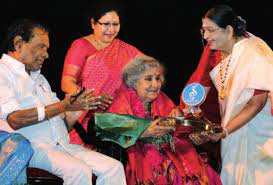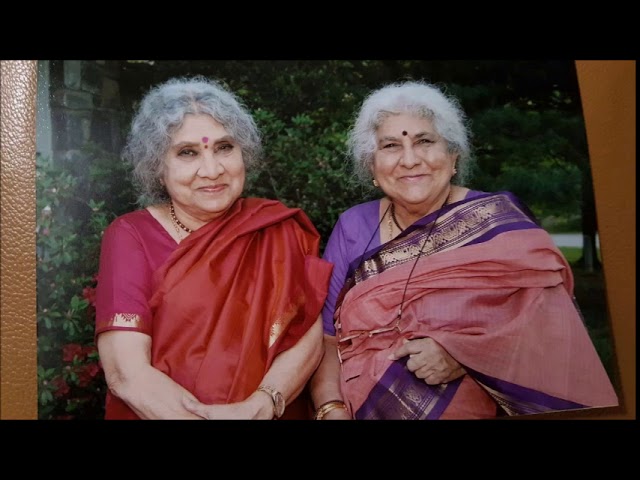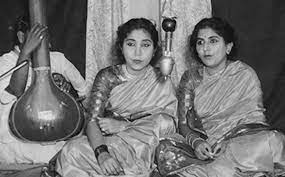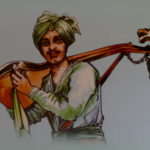Following our Set of Articles on Folk culture, namely Janapada Sangeeta & Janapada Nrtya, comes a natural follow-up on notable personalities who had an impact in this arena. We tend to see Folk and Classical as dichotomies, when in reality they can & do influence each other.
Often times in life, cultural forces come as siblings. One will be older or might shine a bit brighter, but the effect of the two can be felt across the region. One such pair of siblings came in the form of Anasuya & Seetha Devi, better known as the Vinjamuri Sisters.
Background
The sisters originated from coastal Aandhra, fittingly, in one of the Trilinga kshetras (Kaaleshvaram (Telangana), Bhimesvaram (Kosta), & Sreesailam (Rayalaseema). Seetha Devi was the elder, and her younger sibling followed not far behind.
“Born in May 1920 in Kakinada, Andhra Pradesh, Anasuya was also adept at playing the harmonium. During the freedom struggle, she popularised the song ‘ Jaya, Jaya, Jaya Priya Bharata Janani’ composed by Krishna Sastry.” [2]
Bhimesvaram, also called Draaksharaamam, is an ancient centre of Aandhra tradition. The Vinjamuris were an eminent family of high culture, with accomplished relatives as well. Merit and family contacts frequently go hand-in-hand.
Hailing from “a family of poets and musicians (father was a Telugu-Sanskrit scholar, mother launched Telugu’s first women’s magazine and uncle Devulapalli Krishna Sastri was a renowned poet), Anusuya and her sister Sita took to light music and soon became a household name.” [1]
They were tutored in Sanskrit, classical texts, and Telugu poetry at a very young age. [4]
“Little Anasuya’s initiation into classical music began with Sonti Lachiah—a descendant of Tyagaraja’s guru Sonti Venkataramanayya, and continued with Munuganty Venkata Rao.” [4]
The two siblings then began their march to fame. Their well-connected family was able to ensure them a deserving place on the regional and eventually national stage.
“A child prodigy and gifted singer, Anasuya made her singing debut at the age of 8, with a gramophone record of her songs. Thereafter, for a good seven decades, she sang, wrote, researched and lived folk songs to the delight of millions of her listeners across the world.” [2]
“Krishnasastry developed a penchant for Brahmo Samaj and penned songs for the organisation that worked for social renaissance…they sang those songs in many public meetings. ” [3]
Indeed, Anasuya would climb to national level fame, and even performed before Mahatma Gandhi & Netaji Subhash Chandra Bose. She was also prominent in cinema. “For those familiar with the box-office hits of Telugu cinema in yesteryears, the tune of the famous song Manasuna Mallela in Malleswari was based on ‘Chandana charchita’, a song rendered by Anasuya in 1937.” [2]
A people’s spirit is preserved in its memory and songs. The sentiments, the lyrics, and the tunes define their essence, attitudes, and even mentalities. The sweet simplicity is often forgotten in the pursuit of sophistication and aesthetics. But what rasikas and sahrdhayas often forget is that simplicity is the highest form of sophistication. Cumbersome compounds only show pedantry, rather than artfulness and skill in congealing communication to a few maatrkas. It is for this reason that vaidharbhi was superior to gaudi and Kalidasa forever defined Sanskrit poetry.
Similarly, classical music (and dance) today has been appropriated by global stage arrivistes who have forgotten our cultural essence. They make pretence to asserting that Carnatic music or Saastriya Sangeetha in general suppressed or can presume to take the place of jaanapaadheeya sangeetha. Fortunately, emic criticism of this by orthodox practicioners with lived experience, exists today.
The two, in fact, existed along side each other and mutually informed each other. Each had its role. When out of balance, one may dominate the other, as the over-refined did in colonial times, and as kitschy backbencher fare predominates today. But it is in the simplicity of village life, living close to the land and nature, that our inner humanity (with all its foibles) is once again revealed. Indeed, it is the essence of the village and small towns that must be restored today’s cities and urban jungles. The younger sister did precisely that.
“From there, Anasuya Devi left for the then Madras from where she went to Houston in the US. “Anasuya Devi was a courageous woman, who broke all the shackles and moved freely on a par with men in those days. Her independent nature made her special among the family and her voice added beauty to many lyrics of Krishnasastry,” recalled Tallavajhula Patanjali Sastry, a close relative of the family and writer and environmentalist from Rajamahendravaram.” [3]
The elder would make her name individually as well.“Seetha Devi, too, contributed music for the 1980 award winning film Maa Bhoomi produced by B Narasinga Rao. Her composition in the film titled Bandenaka Bandikatti Padhaharu Bandlu Katti, sung by the revolutionary poet Gaddar, is legendary and won the Nandi Award.” [2]
Seetha gaaru left this world on May 17, 2016. Anasuya gaaru passed away on March 23, 2019. She is survived by 5 children, multiple grand-children, and 4 great-grandchildren. [3]
Achievements
Though often a dynamic duo, particularly in early life, both the sisters would go on to make their own names. The two would settle down with family in the United States.
Seetha Devi carved out a name for herself through multiple achievements.
- Nandi Award Winner
- Was a producer of Folk Music for All India Radio
- Composed Music for the film Maa Bhoomi & notable poets
- Compiled the book ‘Folk Music of Andhra Pradesh’

- Received Kalaa Prapoorna Award & multiple State & National Accolades
- Sang patriotic song(almost became national anthem)before Mahatma, Netaji & Nehru [4]
- Documented her life in biography ‘Asamana Anasuya’
- Eminent composer & musicologist in Aandhra. Published by Bharatiya Vidya Bhavan
- First female music director in South India [4]
- First to publish on light (lalitha) & folk (janapada) music in Aandhra
- “Anasuya Devi has documented her work in seven books on folk songs. Two of the well-known ones — Bhava Geetalu and Jhanapada Geyalu , a compilation of folk songs, were released in Chennai in a function in 2008.” [2]
Legacy
Over the course of a century, Anasuya & Seetha Devi emblazoned the culture canvas of Aandhra. At a time when aspirations for independence were flowing across Colonial India, they transmitted a message of Social Equality, appropriately using the popular medium.
“On trips to nearby Pithapuram, the child watched villagers, as they sang in the fields—songs of seeding, watering, replanting and reaping harvests. She sang after them enthusiastically. Not long afterwards, Anasuya Devi was to pioneer the collection of such songs, and present them on stage, giving them the status of Carnatic kritis.” [4]
True to their family roots, the Vinjamuri Sisters would leave an impact beyond the august classical sabhas of yore and reach the masses-at-large.
“I belong to a family of poets and artists. My ancestors were diwans and pundits at the Pithapuram court,” she told me with pride. Father Venkata Lakshminarasimha Rao, a Telugu-Sanskrit pundit, was a scholarly author and amateur stage actor. Mother launched and edited Anasuya, the first women’s magazine in Telugu, featuring women writers and Ajanta style illustrations. “The Maharani of Pithapuram sent recipes from the royal cuisine!” Anasuya was named after the magazine.”[4]
Yet how quickly Aandhras forget their own culture and cuisine in the need to be fashionable and popular. Pithapuram and Vijayanagaram have long been our cultural lodestones among others, yet today, authentic Aandhra culture does not resonate. It is the kalthi of the current trends and kitschy concoctions of the silver screen that scintillate and captivate the people. Perhaps then, it is time to revive the old medium for the benefit of the new generation. Perhaps it is time to remind them of their true culture which, more than any political lines on a map, better define and elevate them.
““Seetha and Anasuya popularised folk music in the combined Andhra State. They were the first singers to give concerts with folk songs,” recollected V.A.K. Ranga Rao, renowned historian of music, who shared an association of 65 years with the Vinjamuri family. “[3]
References:
- ‘The Grand Dame of Telugu folk songs’. The Hindu. (Jan 29, 2010) https://www.thehindu.com/books/Grand-dame-of-Telugu-folk-songs/article16840318.ece
- ‘The Vinjamuri Sisters-End of an Era in Folk Music’. The Hindu Business Line. https://www.thehindubusinessline.com/news/variety/the-vinjamuri-sisters-end-of-an-era-in-folk-music/article26644051.ece
- ‘Obituary: Anasuya Devi’. India Herald. https://india-herald.com/obituary-anasuya-devi-p6920-65.htm
- Ramnarayan, Gowri. ‘Profile: Anasuya Devi’. Sruti Magazine. May 2017







